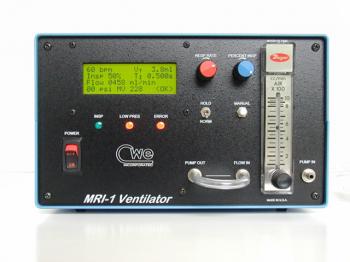MRI-1 - MR-Compatible Ventilator System For Imaging Applications
The MRI-1 ventilator system is compatible with NMR units. It can also be used in electrophysiological experimental setups where electrical circuitry can be a source of interference.
- Overview
- Specifications
- Links
Features:
- Pneumatic valves without magnets (XS, S, & M sized valves available depending on weight of animal)
- Reliable electronic only ventilator
- A wide range of tidal volumes and rates
- Monkeys to Mice (up to 10kg with appropriate valve & accessories)
- Safe with anesthesia and oxygen
- Instant reading of rate and volume
According to the flow-time concept, the MRI-1 creates a known volume by establishing and gating an inspiratory airflow into the animal for a predetermined amount of time. With only three front-panel settings and a large range of volumes, breaths per minute, and I/E ratios conceivable, this method offers amazing flexibility. An internal airpump provides breathing airflow for small animals. Instead, a pressurized gas supply can be connected outside (oxygen or anesthetic gasses). Every ventilation parameter is computed and clearly presented.
The remote pneumatic valve actually switches the airflow. Dead space and tubing compliance are reduced by placing this valve close to the animal, if required even inside the magnet bore. There are currently a variety of valves accessible for animals including mice and pigs. Larger valves can be acquired later if necessary, and rodent-size valves are provided as standard.
Operation
It's simple to set up and use the MRI-1. Respiratory airflow and pneumatic control pressure are delivered to the valves via flexible tubing that connects the control unit and the valves. There are just three controls needed: the respiratory rate, which is set in breaths per minute; the flow rate, which is set using the front-panel flowmeter and internally measured by a mass flowmeter; and the percent inspiration, which is set to determine the ratio of inspiration to expiration time (I/E ratio). In the LCD display on the front panel, all respiratory parameters are displayed. While the flow rate is altered, the tidal volume and minute ventilation indicating the current settings are also continuously presented.
Expandable
The MRI-1 can be applied in settings other than magnetic ones. This equipment is especially well suited to delicate electrophysiological recording settings because the ventilation valves are non-electrical in nature. The MRI-1 accommodates any solenoid valve assemblies made for the well-liked SAR-1000 and SAR-830/AP ventilators in addition to the common tiny pneumatic valves. It is also possible to ventilate multiple rodent-sized animals simultaneously with the MVA-4 multi-valve expander while only using one MRI-1 as the control unit. Yet, tidal volumes are independently set by adjusting the flow rate to each valve assembly while the exterior valves function in synchrony.
Installation Requirements
The pneumatic valves must be operated with a source of compressed air that is between 20 and 50 psi. The pressure is internally turned on or off as needed for remote valve control, and it is coupled to the unit's rear panel. The switchable 120/240VAC operation is available on all versions.
You can also visit site of the manufacturer.


